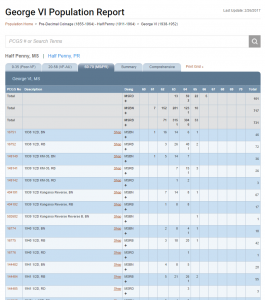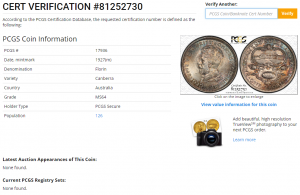The biggest third party grading service in the world is PCGS, the Professional Coin Grading Service based in California in the USA. For a fee they will independently grade and slab your coin. Once slabbed, PCGS graded coins are given a guarantee of authenticity i.e., it’s a genuine coin and not a fake and also that it has not been cleaned or tampered with in some other way that is detrimental to the value of your coin. It is given a grade which is a great place to start in determining if that coin is of the calibre that you would like to see in your collection. I say that their grading is a great place to start because every grader has their own differences in determining a coins’ grade and there are other factors affecting a coin which may appeal or not to yourself as the purchaser of that coin. Examples of these other factors may simply be eye appeal, toning, die cracks or strike. The reasoning behind how PCGS comes up with their gradings has been looked at in great detail by leading Australian Numismatist Dr Peter Andrews.
There’s a table on the pcgs.com website explaining their grades and grading system. It helps give us an overview of what we can expect from a coin when it is given a grade. As an aside to this a genuine coin that has sustained some sort of damage such as cleaning, etching, artificial toning, whizzing, severe planchet flaws, mechanical damage, or residue due to PVC damage may also be slabbed as “genuine” but is not given a grade by PCGS due to the damage. PCGS will not slab counterfeit coins.
Once a coin is graded by PCGS it enters their population report which is a table of what coins have been slabbed and the grades they were given. It shows you all other coins that have been slabbed by their service and their grading so you can get an idea of the entire PCGS graded population. The PCGS population report gives you an idea of how common a particular coin might be in a particular grade. After glancing at the table for a particular denomination and year you can then make your own assumptions about the difficulties of obtaining a high grade coin. You should be aware that the populations of each coin should be taken with a grain of salt. Sometimes coins are broken out of slabs and submitted for re-grading in the hope of getting a higher grade. So a population of 8-10 coins may well be the same few coins resubmitted several times. This is especially prevalent with US Coins, where the difference in grade of just one MS point can be a difference in value of tens of thousands of dollars.

The entire population report for Australian coins can be seen on the PCGS website.
Just look down the table to find which denomination and year you are after. You can also filter these results buy clicking on “filter by prefix” at the top right of the table. This will allow you to sort through all proof coins only or Mint State (MS) grades or lower. If you are looking at the 1962 sixpence, for example, the PCGS number on the far left in the table is the unique number given to only the Australian 1962 sixpence, in this case 17757. This number is also the prefix in the certification number on the slab housing the coin. We can see from the table that currently there is one coin slabbed a AU58 grade and 6 x MS64, 3 x MS65, 11 x MS66 and just 3 slabbed at MS67. Those three coins at MS67 are the highest graded by PCGS and are known as ‘top population’ coins, or the ‘finest graded by PCGS’. Some more enthusiastic (and perhaps less scrupulous coin dealers) might call them the ‘finest known’, which of course they probably are not. There have been a total of 24 1962 6d’s slabbed by PCGS, which is the total ‘population’. Of course this table and the numbers are always changing as new submissions are added to it, and for reasons discussed above the numbers must be taken with a grain of salt.
The top of the population table shows us the total of coins from each denomination that have been slabbed and their grades.
PCGS also breaks down copper coins into 3 different colour grades. Red, Brown and Red/Brown. These are given a short code after their grade eg. MS65RD for Red, MS65BN for Brown or MS65RB for Red/Brown. A red coin is a coin with more lustre much more desirable than a brown coin, which has toned to an almost total brown colour with little or no mint red left. A red/brown is somewhere in between and can cover coins which are basically full red down to those that are almost totally brown. PCGS lacks somewhat in experience with Australian copper coins (in particular those minted in Perth) and what experienced Australian collectors call (and know) a ‘full red’ coin is designated as red brown by PCGS. As a consequence some years it is almost impossible to obtain a penny or half penny with the RD designation and such PCGS hasn’t created codes to categorise those coins in.

Each coin slabbed by PCGS has a certificate sonically sealed inside the slab with the coin. This certificate states the Country, Year, Date, Grade, PCGS number of the denomination/year and a unique number given to that coin only. You can use the pcgs.com website to look up the coin’s certificate number and check it against the actual coin to help you determine it’s authenticity. There have been some fake slabs coming out of the asian market so as a buyer you have to be aware of this and do the necessary visual checks of the coin as well as checking the certificate number. There is also a hologram PCGS logo on the opposing side of the certificate.
